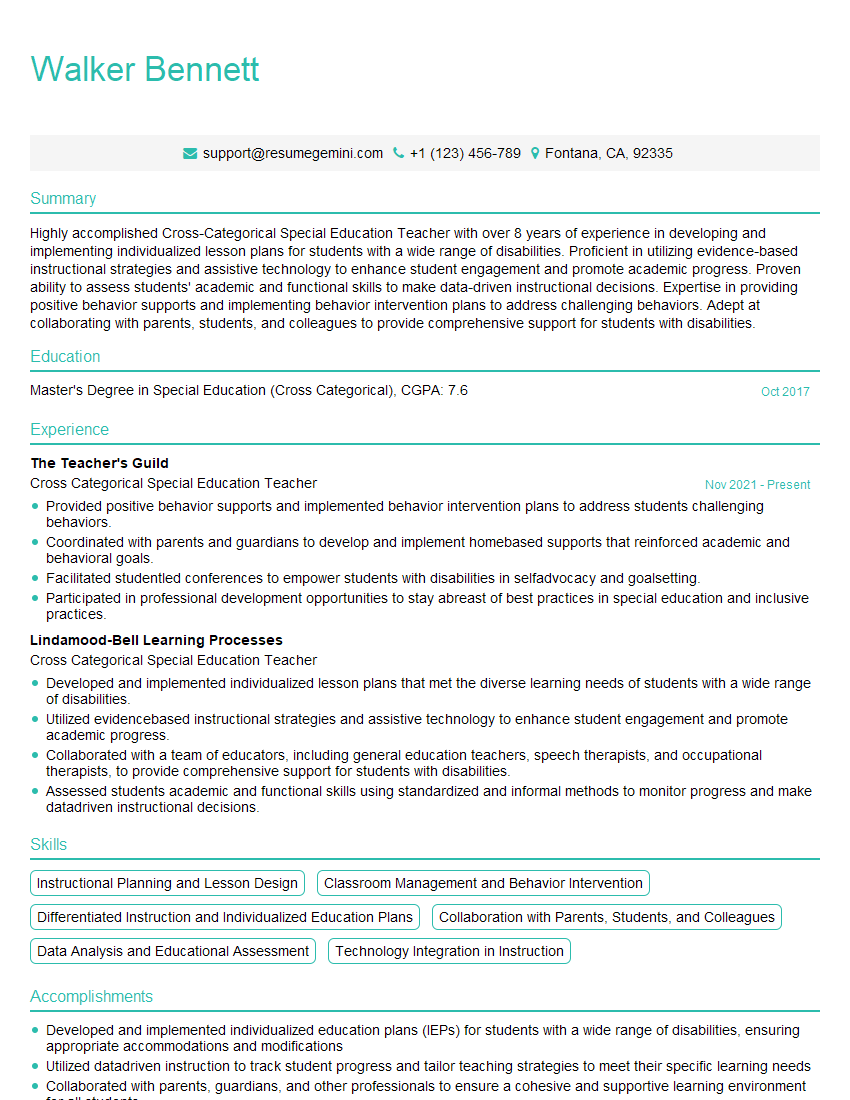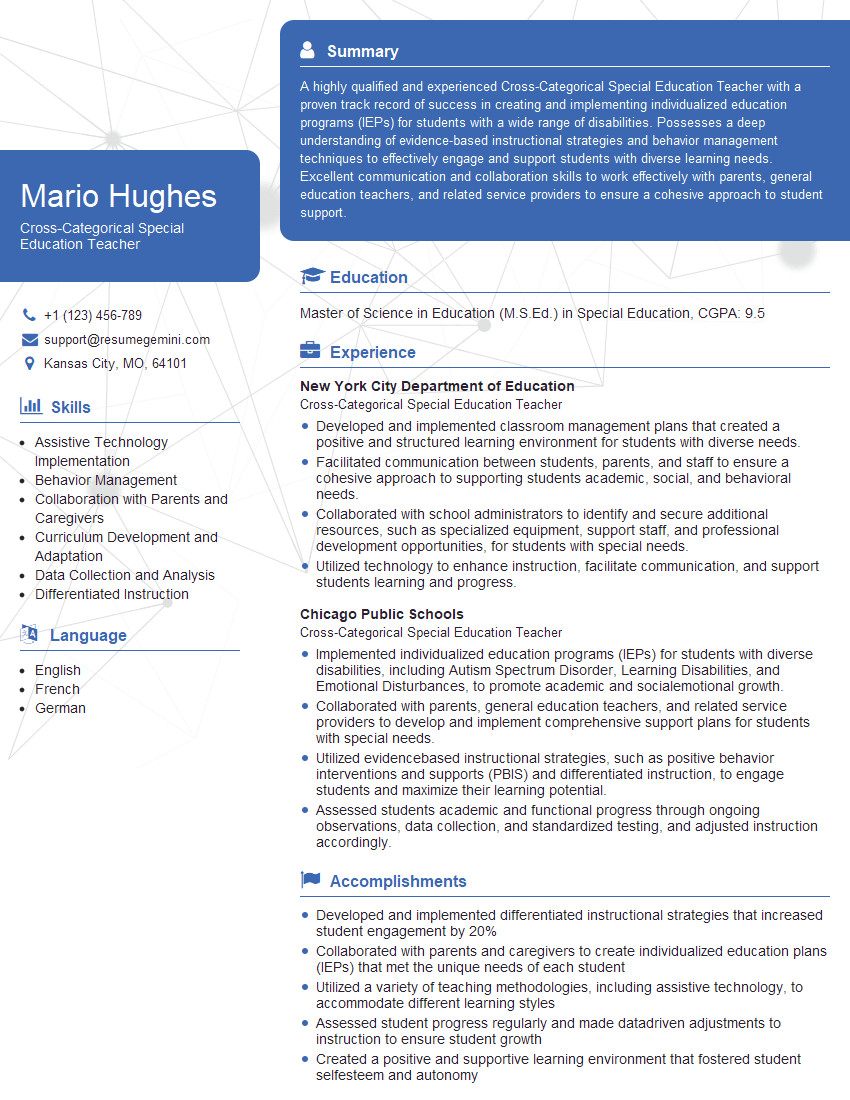Ever felt underprepared for that crucial job interview? Or perhaps you’ve landed the interview but struggled to articulate your skills and experiences effectively? Fear not! We’ve got you covered. In this blog post, we’re diving deep into the Cross Categorical Special Education Teacher interview questions that you’re most likely to encounter. But that’s not all. We’ll also provide expert insights into the key responsibilities of a Cross Categorical Special Education Teacher so you can tailor your answers to impress potential employers.
Acing the interview is crucial, but landing one requires a compelling resume that gets you noticed. Crafting a professional document that highlights your skills and experience is the first step toward interview success. ResumeGemini can help you build a standout resume that gets you called in for that dream job.
Essential Interview Questions For Cross Categorical Special Education Teacher
1. Describe the strategies you employ to cater to the diverse learning needs of students within a cross-categorical setting.
In a cross-categorical classroom, I implement a range of strategies to cater to the diverse learning needs of students:
- Flexible Grouping: I group students with similar learning styles and needs together for differentiated instruction.
- Differentiated Instruction: I tailor instruction to meet the specific learning objectives and strengths of each student.
- Adaptive Materials: I use multi-sensory and modified materials to accommodate varying learning styles.
- Assistive Technology: I utilize assistive technology, such as text-to-speech software and voice recognition, to support students with specific needs.
2. How do you assess students’ progress and adjust your teaching strategies accordingly?
Data Collection and Analysis:
- I collect and analyze data through various assessments, including observations, anecdotal records, and formal assessments.
- This data provides insights into students’ strengths, weaknesses, and areas for improvement.
Adjustments and Differentiation:
- Based on the data, I make adjustments to my teaching strategies to address individual student needs.
- I differentiate instruction by providing different levels of support, modifying assignments, and creating individualized learning plans.
3. Describe how you build relationships with students and their families to support their learning.
- Open Communication: I establish clear communication channels with students and families to discuss progress, concerns, and support.
- Collaboration: I involve parents and families in their child’s educational journey by seeking their input and working together to develop strategies.
- Cultural Sensitivity: I am mindful of cultural differences and strive to create a welcoming and inclusive environment for all students and families.
4. Explain how you incorporate evidence-based practices into your teaching and why they are essential.
- Research-Based Interventions: I implement evidence-based interventions, such as positive behavior support plans and structured literacy programs, to improve student outcomes.
- Effectiveness Evaluation: I monitor the effectiveness of these interventions through data analysis to ensure their positive impact on students.
- Student Growth: Evidence-based practices provide a structured and effective approach that has been demonstrated to promote student growth and progress.
5. How do you use technology to enhance student learning in a cross-categorical setting?
- Assistive Technology: I integrate assistive technology into instruction to support students with specific needs, such as speech-generating devices and augmentative communication tools.
- Differentiated Learning: I use educational apps and online platforms to provide differentiated learning experiences that cater to diverse learning styles.
- Collaboration and Communication: I utilize technology for communication with students, parents, and colleagues, facilitating collaboration and sharing of information.
6. Describe how you work collaboratively with other professionals to support students with special needs.
- Interdisciplinary Team Collaboration: I collaborate with speech therapists, occupational therapists, and other professionals to develop and implement individualized plans for students.
- Sharing Expertise: I share knowledge and expertise with other team members to ensure a holistic approach to supporting students.
- Case Management: I participate in case management meetings to monitor student progress and make necessary adjustments to support plans.
7. How do you maintain a positive and supportive learning environment in a cross-categorical classroom?
- Positive Relationships: I establish positive relationships with students, building trust and respect.
- Classroom Culture: I create a supportive and inclusive classroom culture where all students feel valued and respected.
- Behavior Management: I implement a clear and consistent behavior management system to foster self-regulation and positive behavior.
8. Describe your experience with developing and implementing Individualized Education Programs (IEPs).
- IEP Development: I collaborate with IEP teams to gather information, develop educational goals, and create individualized plans for students.
- IEP Implementation: I implement IEPs effectively, monitoring student progress and making adjustments as needed.
- IEP Reviews: I participate in IEP reviews to assess progress, make necessary modifications, and ensure continued support for students.
9. How do you stay abreast of current research and best practices in special education?
- Professional Development: I attend conferences, workshops, and training opportunities to expand my knowledge and skills.
- Research Engagement: I actively engage with research studies and peer-reviewed literature to stay updated on evidence-based practices.
- Collaboration with Colleagues: I collaborate with other special educators to share ideas and learn from each other’s experiences.
10. What are the unique challenges and rewards of working with students with complex educational needs?
Challenges:
- Varied Learning Needs: Addressing the diverse learning needs of students with complex disabilities can be demanding.
- Communication Barriers: Students with communication challenges require specialized strategies to ensure effective communication.
- Emotional and Behavioral Needs: Supporting students with emotional and behavioral needs can be multifaceted and requires a collaborative approach.
Rewards:
- Impactful Relationships: Building strong relationships with students and seeing their growth is incredibly rewarding.
- Student Success: Witnessing students with complex needs overcome challenges and achieve success is deeply fulfilling.
- Collaboration and Teamwork: Working as part of a team of professionals to support students is a collaborative and enriching experience.
Interviewers often ask about specific skills and experiences. With ResumeGemini‘s customizable templates, you can tailor your resume to showcase the skills most relevant to the position, making a powerful first impression. Also check out Resume Template specially tailored for Cross Categorical Special Education Teacher.
Career Expert Tips:
- Ace those interviews! Prepare effectively by reviewing the Top 50 Most Common Interview Questions on ResumeGemini.
- Navigate your job search with confidence! Explore a wide range of Career Tips on ResumeGemini. Learn about common challenges and recommendations to overcome them.
- Craft the perfect resume! Master the Art of Resume Writing with ResumeGemini’s guide. Showcase your unique qualifications and achievements effectively.
- Great Savings With New Year Deals and Discounts! In 2025, boost your job search and build your dream resume with ResumeGemini’s ATS optimized templates.
Researching the company and tailoring your answers is essential. Once you have a clear understanding of the Cross Categorical Special Education Teacher‘s requirements, you can use ResumeGemini to adjust your resume to perfectly match the job description.
Key Job Responsibilities
Cross-Categorical Special Education Teachers are responsible for providing instruction and support to students with a wide range of disabilities, in a variety of settings.
1. Develop and Implement Individualized Education Programs (IEPs)
IEPs are legal documents that outline the student’s present levels of performance, annual goals, and the specific educational services that will be provided to help the student reach those goals.
- Work with parents, other educators, and related service providers to develop and implement IEPs
- Monitor student progress and make adjustments to the IEP as needed
2. Provide Instruction and Support
Cross-Categorical Special Education Teachers provide instruction and support to students with disabilities in a variety of settings, including general education classrooms, resource rooms, and self-contained classrooms.
- Use a variety of teaching methods and strategies to meet the needs of students with disabilities
- Provide support and assistance to students with disabilities in all areas of the curriculum
3. Collaborate with Others
Cross-Categorical Special Education Teachers collaborate with a variety of other professionals to provide services to students with disabilities.
- Work with parents, other educators, related service providers, and administrators to support students with disabilities
- Participate in school-wide committees and activities to support students with disabilities
4. Stay Up-to-Date on Best Practices
Cross-Categorical Special Education Teachers must stay up-to-date on best practices in special education.
- Attend professional development opportunities
- Read professional journals and books
- Network with other special education professionals
Interview Tips
Preparing for an interview for a Cross-Categorical Special Education Teacher position can be daunting, but by following these tips, you can increase your chances of success.
1. Research the School and District
Before your interview, take some time to research the school and district where you are applying.
- Visit the school’s website and read the school’s mission statement and educational philosophy
- Look up the district’s website and read about the district’s special education program
2. Practice Answering Common Interview Questions
There are a number of common interview questions that you are likely to be asked, such as:
- “Tell me about your experience working with students with disabilities.”
- “What are your strengths and weaknesses as a special education teacher?”
- “Why are you interested in working at this school?”
Take some time to practice answering these questions out loud. This will help you to feel more confident and prepared during your interview.
3. Bring Evidence of Your Skills and Experience
When you go to your interview, bring evidence of your skills and experience. This could include:
- Your resume and portfolio
- Letters of recommendation
- Examples of your work with students with disabilities
This will help the interviewer to see your qualifications and how you can contribute to the school.
4. Dress Professionally and Be on Time
First impressions matter, so dress professionally for your interview and be on time.
- Choose clothing that is clean, pressed, and appropriate for a school setting.
- Arrive for your interview on time or even a few minutes early.
5. Be Yourself and Be Enthusiastic
The most important thing is to be yourself and be enthusiastic about working with students with disabilities.
- Let the interviewer see your passion for teaching and your commitment to helping all students succeed.
- Thank the interviewer for their time and let them know that you are interested in the position.
Next Step:
Armed with this knowledge, you’re now well-equipped to tackle the Cross Categorical Special Education Teacher interview with confidence. Remember, a well-crafted resume is your first impression. Take the time to tailor your resume to highlight your relevant skills and experiences. And don’t forget to practice your answers to common interview questions. With a little preparation, you’ll be on your way to landing your dream job. So what are you waiting for? Start building your resume and start applying! Build an amazing resume with ResumeGemini.

